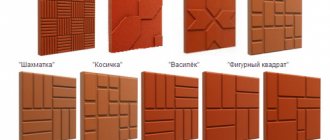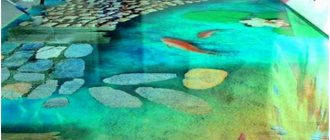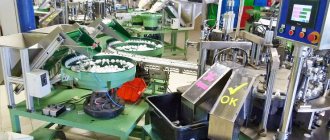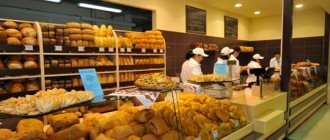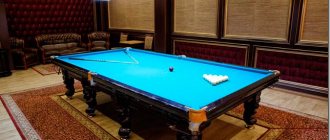Russians eat a lot of sweets; consumption of confectionery products (CI) in our country is one of the highest in the world. In 2020, the average Russian consumed 25.2 kg of sweets. Confectionery sales volumes have been growing by 1-3% every year since 2010. You can earn good money from this love, for example, by opening your own cafe-pastry shop, where you can not only serve customers, but also make sweets to order and for sale in stores.
In the material below, we will take a closer look at why this business is so promising, and we will provide a ready-made business plan for opening a confectionery shop with approximate calculations of the return on investment.
1. Prospects for the confectionery industry 2. Competition in the market 3. Types of confectionery shops 4. Description of goods and services 5. How to open a confectionery shop and what is needed for this 6. What documents are required 7. Requirements for premises and production 8. Location of the confectionery shop 9. Required personnel 10. Selection of equipment for a confectionery 11. Raw materials 12. Advertising 13. Profitability and payback 14. Advantages of a confectionery 15. Disadvantages of business 16. Possible risks 17. Competitive advantages 18. Franchising
Prospects for the confectionery industry
The production/consumption volumes of confectionery products in Russia are growing every year. According to the Association of Confectionery Industry Enterprises (ASKOND), in 2020, 3.7% more sweets were produced than in 2020. The indicator is growing steadily after a slight drop in 2020.
Table 1. Rate of change in the volume of production of confectionery products in the Russian Federation in 2015-2018.
| Year | Production volume, tons | Change from previous year |
| 2015 | 3475.8 thousand | -0,6% |
| 2016 | 3594.5 thousand | 3,4% |
| 2017 | 3758.5 thousand | 4,6% |
| 2018 | 3896.3 thousand | 3,7% |
The data confirms the financial reports of leading confectionery factories with branded retail chains, indicating an increase in revenue.
According to forecasts, the production of sweets in Russia will continue to grow in the coming years. This will be associated both with an increase in sales in the country and with an increase in the share of exports abroad.
Step-by-step plan for opening a confectionery shop
Let's look at a step-by-step plan on how to open your own confectionery shop
Step 1. Drawing up a detailed business plan. Determining the business format
There are several formats for the confectionery business:
- Home production. In this case, the start-up investment is minimal; there is no need to rent premises and hire employees. It is also not necessary to register an individual entrepreneur - it is enough to register as a self-employed citizen (if you work in a region where this tax regime has been introduced). But both production volume and income will be small.
- Confectionary shop. In this case, you will need premises, professional equipment and registration as an individual entrepreneur or LLC. But this format does not involve opening a cafe - to sell products you need to negotiate with stores.
- Confectionery cafe . In addition to its own production, the cafe sells cakes and confectionery that can be eaten right there at the table. It is not necessary to look for additional sales channels, and the sale of drinks will become an additional source of income (selling drinks is profitable, since the markup on them in cafes is usually higher than on cakes and pastries). But the entrepreneur will not only need to find premises for the workshop: this premises must be located in a good location, and the rental price will be higher than in the case of a confectionery workshop.
The business plan needs to describe your establishment in detail: business format, product range, pricing policy, location, opening hours, target audience, market analysis in your region and competitor analysis.
You also need to describe all stages of organizing and launching a business (production plan), calculation of expenses and planned income (financial plan), promotion activities (marketing plan), and risk analysis.
Step 2. Finding and concluding a rental agreement for the premises.
The requirements for the premises depend on the format and volume of production. For a confectionery shop, they usually take a room of 70 square meters. meters, where there are all the necessary communications (gas, water, sewerage, electricity, ventilation). The location is not too important, but transport accessibility is important - confectionery products will need to be transported around the city.
For a café-pastry shop you need premises in a good location, perhaps in the center, near business centers or shopping centers, universities, office buildings. But this could also be a residential area (provided that solvent clients live there). It is ideal to rent a room where there used to be a cafe - in this case, it exactly meets the requirements of the inspectors. Room area - from 30 sq. meters for a hall and from 50 sq. meters - for kitchens and industrial premises.
The premises also need to be renovated. For a workshop, this step can be skipped if the premises are in good condition. In a cafe, in addition to renovation, you need to think about the interior and design.
The room should be divided into zones:
- Production room;
- Refrigerator for ingredients (in a separate room)
- Refrigeration chamber for finished confectionery products;
- Administrator's office;
- Toilets for staff.
The cafe premises must also have a sales area and toilets for customers, as well as at least two entrances (main and service).
There are separate requirements for production premises:
- The walls are covered with tiles, and the ceilings are whitewashed with lime mortar;
- Floors are made of smooth, durable materials, without gaps;
- There are requirements for the power of electrical networks for the normal operation of professional equipment;
- It is mandatory to have fire extinguishers in each room and a fire evacuation plan.
Step 3. Registration, obtaining permits and licenses
You need to register an individual entrepreneur or LLC. For one institution with one founder, it is better to choose the individual entrepreneur format.
- Registration with the tax service;
- Permission from the SES and State Fire Inspectorate;
- Registration with the pension fund (if there are employees) and the Social Insurance Fund;
- Opening a bank account and registering a cash register,
- Concluding agreements with suppliers, agreements for garbage removal and disposal, disinfestation and deratization, washing tablecloths, napkins and uniforms.
Additional package of documents for cafes and confectionery shops:
- The conclusion of the Sanitary and Epidemiological Service on the compliance of the premises with all standards, as well as an addition to it - the range of products and recipes of dishes;
- Sanitary passport of the premises;
- Production control program;
- Certificates of conformity for the entire range.
Step 4. Search and purchase equipment.
The cost of purchasing professional equipment can reach 80% of the initial investment. You will need:
- Powerful electric stove,
- convection oven,
- Proofing cabinet,
- Hood,
- Cream boiler,
- Confectionery and production table,
- Device for sifting flour,
- Dough mixer,
- Ovoscope,
- Wiping machine,
- Freezer and refrigerator compartment,
- Waffle iron,
- Mixers,
- Scales,
- Shelving,
As well as baking equipment (tins of different diameters, nozzles, whisks, pastry bags).
For the sales area you need a coffee machine, a coffee maker and coffee grinder, a cocktail mixer, a juicer, a blender, a cooler, and an ice crusher.
Equipment and furniture for the sales area : tables and chairs, hangers, racks and display cases, refrigeration cabinet, counter, cash register. You will also need dishes, air conditioning, lamps and chandeliers, and bathroom equipment.
Step 5. Hiring staff
The number of personnel depends on the format and capacity of the enterprise: for example, in a small cafe only three or four people can work each shift, but a large confectionery shop needs a conveyor line and at least 10 employees.
The workshop usually employs a technologist who develops the recipe and monitors the quality of the product. The main production work is performed by cooks and their assistants. In a cafe you need to hire a cashier, a dishwasher/cleaning lady, a barista, waiters (if it is a self-service cafe, you can do without them, but in this case you need a person working in the distribution). Since the cafe is usually open from 9-11 am to 9-11 pm seven days a week, the staff will work in two shifts. Accounting can be outsourced.
Step 6. Advertising and establishing sales channels.
If you have a confectionery shop, it is important to establish connections with stores - without this, you will have nowhere to sell your products, which also have a very limited shelf life. To do this, you need to allocate 1-2 employees who will prepare and send commercial proposals and go to meetings with potential customers.
To promote a cafe, the key to success is a good location and a bright sign. If you also always have delicious and fresh baked goods, the flow of customers is guaranteed. Additionally you can use:
- flyers, leaflets,
- outdoor advertising,
- advertising in elevators,
- promotion on social networks,
- promotions and bonuses (for example, happy hours).
Competition in the market
The confectionery business is highly competitive. There are many Russian and foreign manufacturers operating on the country's market.
Let us highlight the main groups of competitors with whom the new businessman will have to share the market.
Firstly, these are large confectionery factories, among which there are well-known companies that have been operating since Soviet times. Their sweets are known and loved by Russians. Large companies sell finished goods in all regions of the country.
Secondly, regional confectionery factories operating in specific regions and areas.
Thirdly, private confectionery companies, restaurants and bakeries operating within a locality or their area.
Fourthly, foreign manufacturers, chains of cafes and confectioneries. Foreign sweets of both economy and premium class are sold on the shelves.
Types of pastry shops
- Home mini pastry shop. This format is for people who do not have sufficient capital for a more serious business. Setting up a business at home does not require large investments. The main problem here is developing a client base. You can sell your sweets to friends, acquaintances, their acquaintances, or to small retail stores.
- Manufacturing enterprise. This is a confectionery shop (full/part-time), which will require serious investments in equipment, personnel, inventory, and marketing. A larger scale of production opens up the opportunity to create a large distribution network and increase revenue and profit.
- Cafe-patisserie. It combines both production and sales. In this case, the business will be built more on local retail sales, although it is possible to create sweets for sale in other places.
You can sell sweets online.
Cake to order
Cake is the favorite sweet of a huge number of people. Baking cakes is a hobby that can grow not only into an additional source of income, but also into your own small business. For such a startup in the “home-baked” format, even in the complete absence of cooking equipment, 30 thousand rubles will be enough. However, today few people will be surprised by a simple cake like Napoleon, so you need to think carefully about the ideas for decorating your cakes. An excellent option for advertising sweets would be to post photos of cakes on Instagram.
Read a guide to starting a cake baking business See 300 cake decorating ideas See a selection of the best Instagram accounts about the art of pastry
Description of goods and services
You need to attract visitors both with high quality and a unique assortment.
CIs are divided into several groups: flour, sugar confectionery, chocolate, cocoa. At the same time, chocolate traditionally ranks first in demand.
There are fewer flour products being made, but the demand for them has been growing recently; these are cakes, pastries, croissants, etc.
The assortment of the confectionery-bakery can include the following items:
- cakes and pastries of several types;
- cupcakes (muffins), croissants and donuts;
- pancakes and pancakes;
- cookies and waffles;
- gingerbread;
- candies;
- own chocolate of original recipe.
The specific offer depends on the capabilities of the enterprise and the size of the initial capital.
Prospects for the development of the confectionery industry
The current article will focus on the relationship between consumer demand and development trends in the confectionery market. In particular, the material pays attention to innovative technologies for manufacturing confectionery products. The article gives a detailed description of the “English flower technique” - as the newest method of decorating products. The main feature of the method being studied is its desire for naturalism. Confectionery products decorated with the studied technique belong to the elite class and are considered real masterpieces of the modern confectionery industry.
The main material for making such flowers is glaze and mastic, which are produced on an industrial scale. However, manufacturers of high-end confectionery products strive to produce these components themselves, according to their own recipes. This allows them to add even more uniqueness to their products and improve existing fondant and glaze recipes. It is these new recipes for these ingredients that will be discussed in the final part of this article.
The confectionery industry has been experiencing dynamic development over the past 25 years, attracting more and more new investors. This industry is distinguished by its high profitability and allows you to quickly develop the most daring business ideas. Such dynamism in the development of the industry is due to the construction of new enterprises and the modernization of old ones, the emergence of new production technologies, the desire for higher quality products and increased competition in the global confectionery market.
The main interest for manufacturers at present is in technologies to reduce the sugar and fat content in finished products, using more and more natural ingredients. This trend is caused, in turn, by consumer interest in a healthy and balanced diet. The issue of the usefulness of confectionery products is especially acute for athletes and people leading an active lifestyle. Accordingly, the demand for fortified sweets, energy bars and other sports and dietary nutrition products is growing.
Most manufacturers now use scientific hypotheses about the beneficial properties of chocolate in their marketing, using this information to advertise and promote new dietary products to the people. For example, among scientists there is an opinion about the ability of cocoa to prolong life. Many innovative products now increasingly use so-called smart chocolate, which has an immunostimulating effect.
Decorating with fruits is very popular.
Organic products are especially popular among consumers, which directly affects the confectionery industry. Consumer tastes are becoming more and more sophisticated, and enterprises have to constantly improve their technologies in order not to lose demand for their products. In particular, consumers began to pay more attention to fruits. Moreover, for people, fruits have ceased to be a luxury, but have become a necessity.
In connection with this market trend, enterprises have to develop their technical and production potentials and increase production volumes. This, in turn, places an additional burden on the financial activities of organizations. On the other hand, the use of innovative technologies and expansion of production volumes increase the profit of the enterprise.
Therefore, scientific and technological progress is of fundamental importance for the confectionery industry. With the current level of competition among manufacturers, the leader becomes the one who uses the latest technologies that have undeniable advantages. In the market, this leadership is expressed in the development of new and unique confectionery products.
But, in addition to technical innovations, the human factor is also of utmost importance in the confectionery industry. In order to turn an ordinary cake into a real masterpiece of culinary art, it is not enough to use the latest technology. It is important that the confectioner who will be involved in the production has a developed imagination and artistic taste, and is familiar with the concept of true beauty. Therefore, often the professional qualities of a confectioner are much more important in the competitiveness of an enterprise than innovative production or equipment.
Confectionery products should be attractive with their appearance. It should be beautiful and appetizing to look at, because, as a rule, it is a beautiful cake that becomes the main attribute of the festive table. Decorative elements play the main role in giving the desired appearance. To create the latter, theoretical knowledge and practical skills in fine graphics are required. A master pastry chef must be constantly ready to solve non-standard problems and implement his creative ideas. He must have the mindset of an artist, be able to draw a certain image in his head and transfer it to reality. The pastry chef must not only be able to draw an image on paper, but also evaluate it critically and fashion it into a real product.
The quality of work must meet certain criteria. For example, the surface of the cake should be decorated with a clear and complete pattern, with a harmonious color combination. Products that use glazing with fondant or jelly must have a mirror-like surface with an even coating that does not violate the boundaries of the product.
In modern industries, semi-finished products or pre-fabricated components are often used to increase labor productivity. Confectionery products should be attractive with their appearance. It should be beautiful and appetizing to look at, because, as a rule, it is a beautiful cake that becomes the main attribute of the festive table. The main role in creating an appetizing look is played by decorative elements that decorate cakes and pastries. To create such elements, finishing semi-finished products are often used using various techniques and techniques.
It takes time to learn how to create real decorative masterpieces. Therefore, it is best for beginners to start with the simplest elements, and then gradually complicate the tasks.
Technology for applying cream and paste-based jewelry
To dose these components, various devices are used in the form of combs, cornets and depositing bags with metal or plastic tubes. When using cream fillers, you should remember that to create reliefs it is better to use components based on butter cream. Brands of creams such as Charlotte, Glasse, protein custard cream, and Zephyr cream are perfect for this purpose.
The glaze used to create elite decorative elements is called royal glaze. It can be used immediately or stored for a certain period of time. It is used to create architectural elements, representatives of flora and fauna, as well as geometric shapes. To begin with, the products are formed on a parchment sheet, waited to dry at room temperature, and then transferred to the general composition.
Among the latest technological developments, we should highlight a new type of sugar glaze that retains elasticity even after drying, which allows you to change the shape of decorative elements and create even more unique compositions. Along with standard fillers, chocolate glazes, velors and fat masses for finishing the side parts of the product are increasingly being seen in production. This list also includes sugar pastes and sugar-fat mixtures, as well as jelly fillers.
The main material for making flowers using the English technique is glaze and mastic, which are produced on an industrial scale. However, manufacturers of high-end confectionery products strive to produce these components themselves, according to their own recipes. This allows them to add even more uniqueness to their products and improve existing fondant and glaze recipes. This freedom of choice is provided for the purpose of selecting a mastic with the required elasticity and hardening speed. For example, to create a bouquet you need a quick-drying mastic, which at the same time will not lose its elasticity too quickly, which will allow you to create the desired curves and shapes.
The embodiment of the “English flower technique” in cake decoration.
Modern technological properties of sugar mastics make it possible to create decorative elements with a high degree of naturalism. However, in order to give the flowers and leaves a more vibrant look, it was decided to improve the recipe of the currently used flower mastic.
The recipe of the English confectioner Alan Dunn was taken as the basis. The improved sample contained the following components: powdered sugar (500g), gelatin (12g), CMC (10g), chicken protein (31g), coconut fat (30g), starch syrup (50g) and water (35g). The total weight of the feedstock was 665g. As a result, the resulting mastic had greater manufacturability compared to its predecessor. It was easier to roll out, it quickly took the desired shape and was better fixed, and faster hardening and the presence of a waxy sheen in the finished decorative elements were noted. The only disadvantage of the mastic was that the elements turned out to be quite thick and were less susceptible to drying.
To give vibrant realism to flowers and leaves, waxy shine and visual effects are necessary. Decorative elements should be made carefully and look weightless. To solve this problem, an improvement was made to the standard recipe for milk sugar mastic. Among elite decorative elements, the rose remains the most popular. However, using a factory-made product is unlikely to be the best option for creating an elite-class cake. The basis for the manufacture of this element was the mastic developed by Voskhod LLC.
The developed technologies and recipes were introduced into the work of Voskhod LLC. Further marketing analysis of the production established that the use of English flower techniques is in great demand among buyers.
How to open a confectionery shop and what you need for it
The most expensive expense item when opening a cafe is the purchase of all necessary equipment. The calculation increased the share of expenses allocated to marketing. In a highly competitive environment, your business needs to be actively promoted to gain a foothold in the market.
Table 2. Initial costs for opening a flower shop.
| Expense item | Cost, rub. |
| Registration | 70 thousand |
| Room rental (120 sq. m) | 350 thousand |
| Equipment and inventory | 2.5 million |
| Raw materials | 150 thousand |
| Salary, 9 people | 300 thousand |
| Additional expenses | 550 thousand |
| Total | 3.920 million |
Work and sales are expected in a city with a population of 1.5-2 million people. Additional expenses include the costs of utility bills, premises preparation, marketing, etc. The amount of tax deductions is not taken into account in the calculation.
What documents should I submit?
You can start a business in the form of an individual or legal entity. The first case - working as an individual entrepreneur - is more suitable when opening a cafe-confectionery, it will reduce costs, simplify matters with the Tax Service, the cash register, etc.
When registering, the OKVED codes are indicated:
- 10.7 “Production of bakery and flour confectionery products”;
- 10.82.2 “Production of chocolate and sugary confectionery products”;
- 52.24.2 “Retail trade in confectionery products.”
To open a company, you do not need mandatory permission from the SES or Rospotrebnadzor. These services must be notified of the new confectionery; when opening it, all requirements are taken into account.
Agreements are concluded for waste removal with disinsection and deratization stations. All issues must be resolved with the Fire Service.
Requirements for premises and production
A businessman who decides to open a cafe needs to study various regulatory acts. Organizing a business requires compliance with requirements, violation of which can result in significant fines.
You are required to thoroughly study the following documents.
1. SanPiN 2.3.4.545-96. “Production of bread, bakery and confectionery products. Sanitary rules and regulations".
2. SanPiN 2.3.6.1079-01 “Sanitary and epidemiological requirements for public catering organizations, the production and circulation of food products and food raw materials in them.”
3. NTP-APK 1.20.02.001-04 “Standards for technological design of low-capacity enterprises for the production of confectionery products”
The standards adopted during the preparation, repair, finishing of the workshop, during ventilation, water supply, and sewerage are studied. Germicidal lamps are installed in the workshop.
Patisserie location
The area and location of the establishment depends on its type and status. For example, for a premium cafe you need to choose a location in the city center or in expensive shopping centers. Confectionery-bakeries aimed at the masses can be located in other areas of the locality, including bedrooms; the most important thing is that these are places with a good flow of people.
The object can be located on the first floor of a residential building. Rospotrebnadzor gives permission for this if production volumes do not exceed 1 ton per day.
For a cafe you will need a room with an area of 100-120 square meters. m, divided into zones:
- a production workshop with access to warehouses for storing semi-finished and finished products;
- washing;
- waste storage room;
- staff room;
- sales area for customer service.
Required Personnel
When opening a cafe-confectionery, you will need a professional confectionery technologist who can create recipes for delicious desserts and manage the technological process. He must have proven education, skills and experience. The confectioner must know the recipes and production technologies of CI. A creative approach to creating unique recipes and original proposals is encouraged.
Bakers and pastry chefs needed. They must be able to work with professional confectionery equipment, be able to decorate confectionery products, etc. All preparatory work will be done by a couple of assistants in the kitchen.
Waiters and cashiers will serve customers in the hall. At first, the businessman himself will become the administrator of the staff and establishment. Maintaining accounting reporting is the responsibility of the accountant. You will need a couple of cleaners and an agreement with a security company.
Choosing equipment for a confectionery
For a cafe-patisserie you will need the following equipment:
- ovens, hearth and convection;
- electric stoves with burners and ovens;
- dough mixers;
- flour sifter;
- mixers;
- blenders;
- scales;
- Dishwasher;
- refrigerating and freezing chests;
- furniture: cutting tables, cabinets and racks for displaying sweets, etc.;
- kitchen utensils, packaging materials.
In the customer service room you need to make an attractive design and equip it with:
- tables and chairs;
- refrigerated display cases for drinks and perishable products, including pastries, pies, etc.;
- air conditioners;
- cash register equipment;
- other inventory, including interior items.
About 2.5 million rubles are allocated for this expense item.
Interior design project
When creating a design project, the following stages are distinguished:
- meeting of the designer with the customer to discuss ideas and vision of the overall concept of the project;
- inspection, measurement of the object to see if it is possible to embody the customer’s wishes in it - something will have to be abandoned, something will have to be added;
- initial sketches - at least three of them are made, one is approved by the customer;
- 3D modeling – the customer is shown what the design of the confectionery shop and its interior will be like;
- documentation development - a complete package, including plans, drawings, technical descriptions.
Throughout the implementation of the improvement work, the author of the project accompanies this process - repair and finishing work is controlled by him.
The approach to the layout of a store for those with a sweet tooth must be individual - it can be very different from the concept of a café-pastry shop, coffee shop, etc.
Planning stage
At this stage, the designer actively collaborates with the customer, discussing all the nuances, adjusting various points, taking into account:
- type of confectionery - a separate building, built-in premises in a residential building, office building, cafe with a veranda, private parking;
- type of establishment - will it only serve cooking, sell sweets, or will part of the premises be occupied by a full-fledged cafe;
- characteristics of the enterprise - expected productivity, number of seats, hours of operation;
- total area - it is determined how much space will be allocated for a bakery or small bakery, space for accommodating clients, payments, etc.;
- other technical information - approximate assortment, number of employees, warehouse volume, zoning.
For different rooms, certain furnishings and different equipment are required.
What functional areas exist in the confectionery shop:
- premises for buyers - foyer, hall, wardrobe, toilets, etc.;
- staff work area – where the actual cooking takes place;
- utility rooms - warehouses, wardrobe for employees, washing, receiving, etc.
If you plan to deliver fresh baked goods and confectionery products to your home or other stores, you will need a well-equipped parking lot for the company’s cars, the development of convenient access roads, and loading and unloading of goods.
Style stage
First you need to decide on the purpose of the confectionery:
- cafe;
- coffee house;
- department of “sweet” cooking;
- buffet;
- cafeteria;
- pancake or bakery;
- "sweet" bar.
At this stage, volumetric modeling of the room occurs. The style depends on the choice of the target audience. A mini-cafeteria requires a small area, a limited flow of customers, a student cafe has a simple setting, decorated in a youth style, a more expensive establishment has a solid design.
Technological stage
At this stage, it is thought through how all the necessary technological equipment will be placed. To do this, a detailed plan is drawn up, which indicates everything that will be located on the territory of the establishment, namely:
- bakery stoves, ovens, tandoors;
- flour sifters, proofers;
- dough mixing, whipping, seaming and sheeting machines;
- refrigerated display cases, slides, banettes;
- distribution lines, pancake machines, microwave ovens, coffee machines;
- ice makers – if you plan to sell highly chilled products;
- air conditioners, hoods;
- plumbing fixtures for clients, staff, dishwashing, wet cleaning;
- cash register equipment;
- computer equipment for management personnel.
Existing electrical equipment is tied to the power supply system, plumbing - to sewerage and water supply points, gas - to gas pipes. All existing equipment and furnishings must have certificates of compliance with state sanitary standards and radiation safety. The project indicates the volume of production, traffic flow of a given room - this depends on the supply of water, electricity, and the capacity of the ventilation systems.
Interior decoration
The decor embodies the specialization of the establishment: if most of the sweets sold there are made from milk, the decor welcomes various prints with the image of a cow, milk drops, and stylization of a dairy farm. You can develop the idea of “milk rivers” with chocolate and gingerbread banks.
Berry motifs in decoration are suitable for a confectionery shop that has pastries, cakes with fruit and berry fillings. For a “European” bakery, colorful large-format images of bread and all kinds of baked goods are preferred on the facade or external display cases, and stylized figures of bakers are at the entrance.
Decoration materials are preferred natural and modern, suitable in style - natural, artificial stone, wood, MDF, various types of plastic, concrete, drywall, photo wallpaper.
Raw materials
Specific types of raw materials and mixtures depend on the status of the cafe. Premium confectioneries often use more expensive, exclusive ingredients supplied from abroad. Other cafes use simpler raw materials, often made in Russia.
A businessman should find reliable suppliers who sell quality products with fast delivery. Finding them is not difficult, just enter the desired search query on the Internet, but you need to choose your partners wisely. For example, start working with several partners, buying the necessary raw materials in small quantities, assessing the quality of the product and the responsibility of specific suppliers; So choose the companies that suit you.
All production products must comply with GOSTs, have certificates and permits.
- Creation of image attributes - logo, brand name, colors - by which people will recognize the company and product.
- Bright external advertising of a cafe in order to attract attention (lighting, panoramic windows, aroma marketing, etc.).
- BTL promotion: distribution of leaflets, tastings, unusual promotions on holidays, etc.
- Develop a system of discounts and regular promotions for products.
- Promotion of a café-patisserie on the Internet (group on social networks, website, contextual advertising).
- Home delivery services, purchase of sweets and baked goods to go, pre-order.
When selling your confectionery in retail stores, you can hold promotions and place advertising materials there too.
Product range development
Assortment is, of course, a key issue when winning over consumers. On the one hand, sweets and baked goods are an almost universal product that everyone eats. But on the other hand, each person has his own tastes, and this must be taken into account when forming an assortment matrix.
In order to achieve success, it is advisable to include the following product items in the menu:
- Cakes.
- Cakes.
- Cookies.
- Bakery.
- Muesli, etc.
Initially, you should start with time-tested popular recipes (perhaps with the addition). For example, from cakes these are “Napoleon” and “Bird's Milk”, and from cakes you should give preference to macaroons, eclairs, potatoes and curd rings.
Due to the trend towards a healthy lifestyle, many people tend to choose low-calorie sweets, so when developing a menu, you should add a number of low-calorie recipes (or the possibility of replacing some ingredients of standard recipes).
A good idea would be to sell designer muesli. So, the buyer will be able to choose a specific base and additional components (fruits, dried fruits, chocolate, etc.).
Such a product will be exclusive - accordingly, it will be in demand, and a high price can be set for it.
After reaching a certain level of profit, you can think about expanding production and making your own chocolate, etc. The wider the assortment matrix, the more customers will be satisfied with the choice and become regulars. At the same time, it is important to slightly change the sweets sold, adding new ones and removing the most unpopular or unprofitable ones (this is not always the same thing, since a product may be in sufficient demand, but have too high a cost).
Finally, it is important to pay special attention to decoration and packaging, since desserts should not only be tasty, but also attractive.
Profitability and payback
The amount of initial costs is 3.920 million rubles.
Let's assume that the establishment will be visited by 120 people per day, the average bill per client is 350 rubles.
In this case, the monthly turnover will be 1.260 million rubles.
The total monthly costs are 1 million rubles.
Net profit – 260 thousand rubles.
With this calculation, the business will break even in 15 months.
Table 3. Economic justification for the business idea.
| Basic indicators | Meaning |
| Initial investment amount | RUB 3.920 million |
| Monthly expenses | 1 million rub. |
| Average number of clients per day | 120 people |
| Monthly income | RUB 1,260 million |
| Net profit per month | 260 thousand rubles. |
| Payback period | 15 months (27 months) |
You need to understand that this is only a sample of calculations: such attendance is already possible in a more or less developed state. But development takes time - about 12 months if there is advertising.
How much can you earn in the confectionery business?
Let's look at the example of a confectionery shop. Wholesale cost 1 kg. cookies is at least 40 rubles. During a working day you can produce 400 kg. cookies and sell them for 16,000 rubles. In a month (25 working days) you can receive revenue of 400,000 rubles. Minus expenses for employee salaries, purchase of raw materials, rent, utility bills, net profit will be 60,000-70,000 rubles. If there are good sales markets, the payback period for the confectionery shop will occur in 20 months.
For a cafe, the calculation will be different. With an average check of 300 rubles per person (cake and drink) and if there are 100 customers per day, the revenue will be 30,000 rubles per day, and per month - 900,000 rubles. After deducting the cost of rent, salaries, taxes, and the price of ingredients, income can reach 200,000 - 300,000 rubles, payback - from one and a half years.
Benefits of a confectionery
- High demand. Russians love sweets very much, they are ready to feast on delicious confectionery every day. You can find your buyer for any type of confectionery. Demand opens up prospects for expansion. It is enough to stir up interest with advertising in order to develop and maintain a high customer base.
- Interest in sweets does not depend on the season, and on major holidays sales only increase.
- A company can create products in several price segments, that is, serve more and less solvent people. This will increase your target audience.
- High markup. The price of finished goods often includes a 100% markup, which logically increases the profitability of the work, turnover and net profit.
- A cafe can work in several directions: sell sweets at retail, wholesale to stores, make to order, for holidays.
Folk style
This style is performed with an emphasis on milky or white shades in combination with brown tones, red, national motifs work great here.
Facade
The façade of the confectionery shop should be decorated in the same colors as the interior design. An imitation of folk life will look beautiful at the entrance. A path lined with light stone leading to the porch. This option is suitable if you intend to sell sweets made from natural products.
Folk style facade
Folk style facade
Interior
The interior decoration is designed like a kind of village hut. The walls are painted in neutral colors. The floor is covered with light-colored carpeting. You can paint the floor with beige paint or lay light linoleum. Furniture should also be installed in brown.
No small importance is given to details: dishes, chandeliers, and other elements. Jugs of milk on every table for visitors or original rustic furniture will look original.
Interior in folk style
Interior in folk style
Cons of business
Firstly, there is high competition. There are many confectionery factories in Russia that produce high-quality products; This will have to be taken into account when organizing work.
Several factors will help you gain a foothold in the market: marketing, patience and a unique product. You will have to invest more in advertising and promotion, offer customers something new and accept in advance that development will take a lot of time. In connection with all this, you need to have sufficient financial capital.
Secondly, the confectionery has a short shelf life. Production volumes should be clearly correlated with the level of demand in order to reduce the number of delays, that is, unnecessary costs.
Thirdly, the success of the entire business is directly dependent on the professionalism of confectioners and cooks.
An entrepreneur will have to make efforts, both in finding qualified personnel and in the issue of team building (team building) to create a cohesive and effective team of workers.
Classic
The classic style does not need too much introduction; it is universal and successful in any establishment. A classic is something that is not subject to fashion trends, something that is always relevant.
Facade
The façade of a classic confectionery shop is restrained and strict. Warm colors predominate here, and “tasty” accents are correctly placed on the sign and shop window. On the classic façade you can place harmonious posters with great offers and photos of sweets.
Classic style facade
Classic style facade
Interior
The interior decoration is also not distinguished by a riot of colors and shapes. Everything here is familiar to the eye and, at the same time, clean, neat and sound. Furniture made of natural wood or plastic in neutral shades, plain ceramic dishes, and spacious counters are welcome. Wall decor should not be pompous or bright. Pastel colors and decorative elements in the form of herbariums, reproductions of famous paintings, and flower arrangements will be enough.
Interior in classic style
Interior in classic style
Whatever design of the confectionery you choose, you need to understand that everything needs harmony. If you take a specific style, you should not deviate from it. There are, of course, options when several styles are combined, but in this case a professional approach is required. Otherwise, you can ruin everything.
Possible risks
There are several potential risks:
- the difficulty of gaining a foothold in the market (due to competition, government service inspections, etc.);
- the need to take into account regulatory restrictions related to food;
- the emergence of new laws and requirements, tightening regulatory standards for confectionery;
- unskilled work, personnel errors coupled with high demands on the taste and type of CI;
- increase in rental costs;
- dependence on external conditions (suppliers, etc.);
- the emergence of direct competitors (new confectionery shops and bakeries) in one area.
When opening a company, it is better to be prepared in advance for unforeseen circumstances that could interfere with the normal operation of the enterprise. It is recommended to make a list of risks in advance and take steps to prevent them.
Competitive advantages
It is necessary to think in advance about your competitive advantages, how the cafe will differ from other confectioners, how it will encourage people to buy sweets from you.
Firstly, favorable price-quality ratio. On the one hand, the majority wants good quality sweets at an adequate price, but at the same time they are even willing to overpay a little for a quality product. For example, for so-called eco-products.
Secondly, unusual recipes. Most confectionery shops sell traditional sweets, which in many respects are already boring to customers. It is useful to look for new recipes with unfamiliar tastes, test them and offer people something new.
Thirdly, additional services. Deliver to home, sell confectionery online, etc. You can study the experience of Russian and foreign confectionery shops in this regard.
Production of buns, cookies and other baked goods
You can consider the option of a business producing confectionery products for everyday use. These are cakes, pies, buns, etc. The most popular option is the production of cookies. In terms of volume, it occupies 50% of the production of other confectionery products.
It is best to open such a production together with a retail outlet for your products. You can place tables in the pavilion and offer drinks in addition to the main assortment. You will end up with a café-pastry shop with your own production. This approach, with a successful location of the point, will ensure a greater flow of customers.
